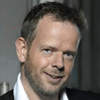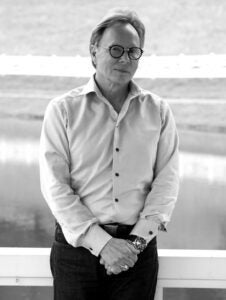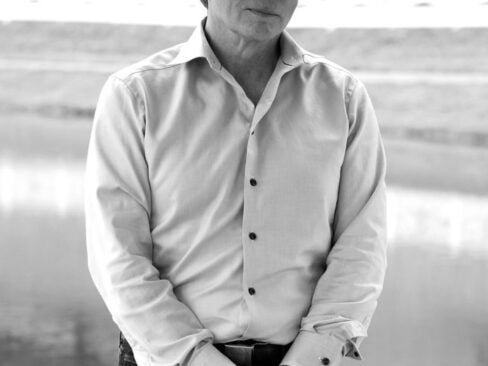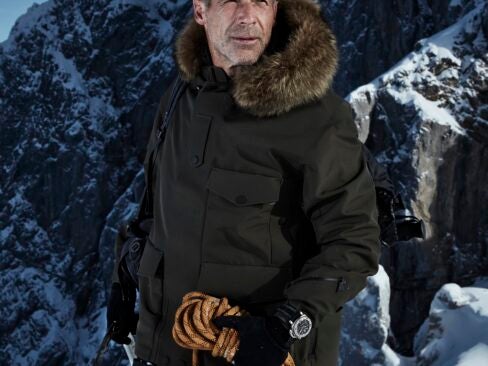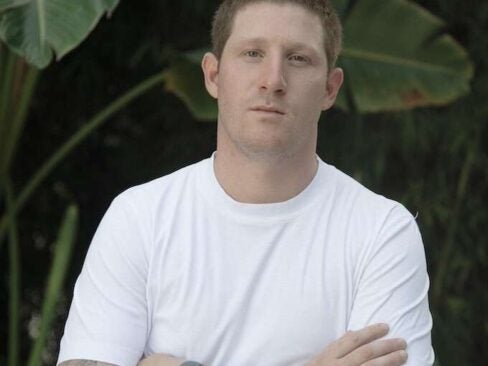
CEORomain Jerome
From the bottom of the Atlantic to the Moon, Romain Jerome’s DNA of Legends collection has shaken the watch industry with both its innovations and controversy. Romain Jerome’s outspoken CEO Yvan Arpa is comfortable being at the center of any conversation, however tense it may be. Recently Elite Traveler Editor-in-Chief Douglas Gollan caught up to Arpa in Geneva after the launch of his second legend.
ET: For our readers who might not be familiar with Romain Jerome, what are the origins of the company and your background as well?
Yvan Arpa: The company was founded in 2005, and at the beginning they were doing a golf watch, which was counting the hits when you’re playing golf. In 2006, I was asked to make an audit of this company, a free audit, and after the audit they asked me to join to reposition the company. So the first thing was to really make an analysis of the market, and to see that there are 618 Swiss watch brands, 72 in Geneva, and most of them speak about the history of the Swiss tradition of watch making, so I wanted to do something else, a bit different.
ET: What were you doing when you came to Romain Jerome?
Yvan Arpa: I was Managing Director at Hublot.
ET: And has your career always been in the watch industry?
Yvan Arpa: No, no, no. I was a mathematics teacher. That was my first job. And then I went to Sector, maybe you’re familiar with Sector No Limits, the concept? It’s a marketing concept, no limits, okay, which was pretty strong a long time ago. And then I joined the Richemont group for a couple of years. Then to Hublot, and now Romain Jerome.
ET: So, you came to Romain Jerome, which is one among more than 600 Swiss watch brands, and the first thing you did was a bit controversial. How did you come up with the concept of “Legends?”
Yvan Arpa: So, 618 brands – what are they doing? The Swiss watch making world is a happy world. They have no outside competition. On the lower end we have the Chinese making nice things. But here it’s between us, it’s between Swiss, well-educated nice people, which I am not because I’m half Italian and I was not educated well.
So what I started to think was, why not doing something a little bit different? Everybody has the same story; they all speak about Swiss watch making traditions, they all claim they do their own movement, they all design. Okay, it’s a little bit boring. The real one, everybody wants a Patek Philippe because it really is a slice of watch making history, it’s really very credible, and then it’s fantastic – from a watch making point of view these are genius people doing fantastic things. But I thought that we could bring something else.
As this brand has no history, Romain Jerome, I took the best watchmakers. They work as well for other brands that don’t tell. I am free to tell because my concept is very different. It’s to say I have no history, so I go toward history with a great age. I go to a legend of our time. And why do you buy watches? It’s not to tell time, because for this you would by a $10 watch. It is more about having a slice of something, a slice of emotion, and I wanted to give a slice of history to people that they can wear on their wrist, this was this idea.
Once this idea was up, you have hundreds of possibilities throughout history. I had 135 “legends” ideas the night I had this idea. And I said, okay, out of 135, let’s take the first one. Like mathematics, you do a hypothesis of work and then you have a solution. The first hypothesis was I wanted the first legend to be worldwide, very well known, because the brand is not known. It’s a new brand, and it will help to sell the product.
Okay, so now my legends list goes down to only 60. Then I said, I want new material in the first timepiece, something new, and something a little bit provocative, because if you have provocation people will speak more. So I thought of bringing rust. The rust is something really incredible because it’s the proof of time that is passing in one way. And it’s the enemy of the watch making world for 400 years. To give it more value than gold was something very interesting for me. That was the second thing.
The third, I wanted the rust to be inaccessible, that nobody can get. And the fourth, the origin of the rust had to be very noble, very, very luxurious. Okay, when you put all this together you only have a couple of possibilities in history, and the one I chose was Titanic.
ET: Do you ever think Titanic was too controversial?
Yvan Arpa: No. The controversy for me was really about the rust. Then some people came up, like judges to say, okay, I should not pursue this because the Titanic is a tragedy. But what I want to say to this is its metal from the Titanic that we melted–a real fusion this time–between steel from the Titanic and steel from modern liners. , So it’s like a rebirth, it’s like a message of hope, like a phoenix. This is the first very positive message. The second is 17 descendants of people who were on the Titanic did order the watch. They purchased the watch because for them it’s like remembering what happened. And the third is really, you know, you cannot forget history. If you forget history you make the same mistake in a couple of years. And one more thing, nobody complained about the movie. They made a lot more money than me. Why don’t people complain? It’s because it’s a love story. But they were diving on the boat and made more mess than I did with my piece.
ET: You just introduced a second legend. What is the new collection?
Yvan Arpa: The Titanic DNA watch was so strong, and that made it a big risk. The risk was really that the brand becomes the model. I don’t want people to say the Titanic brand. The brand is Romain Jerome, and the concept of the brand–DNA of famous legends–is to bring pieces of legends to your wrist. So I said wow, it’s become too strong. I have to launch my second legend faster than I want. From a commercial point of view I still have back orders for three years, even if it’s crisis. But from a strategy point of view it is correct to launch my second legend now.
So for the second legend I still had a lot of possibilities, but the one I wanted is a little bit different. I wanted the same criteria–impossible-to-get material, very well known, very luxurious. And so the same hypothesis applies as before, but I don’t need controversy anymore. Now the brand is very well known world wide, as if I would have had a huge market in PR. So to complement to what I did the first time, which was a legend found 3,840 meters below water, I said let’s go a couple of kilometers above water, huh? I wanted to explore the space conquest, which is the most exciting adventure for human beings. So I said okay, this is fantastic, but if the Titanic is the biggest and the most well known boat ever constructed, making it the most important legend from the marine world, when you look at space there are many.
There’s not just one that pops up as the most important achievement. For me the most important and interesting achievement was this competition between Russia – USSR at that time – and America, in the Cold War, in a fight to prove superiority and become the first to go to the moon, which was the objective.
So I said my piece should make a summary of this incredible competition. It has the objective, it has real moon dust and craters on the dial, which is 1,000% certified. It has an American part, Apollo XI in the bezel, which is melted with modern steel. And it has Soyuz paws on the side, so that is the Russian part. And the bracelet is made of ISS suits, so it’s incredible. This piece has the competition, and the cooperation of the ISS (International Space Station), together. So, all of a sudden, you cannot tell a woman anymore, I will get the moon for you, because now you have to buy the piece. It’s possible to get the moon.
ET: Where does the name Romain Jerome come from?
Yvan Arpa: It’s the son of the founder, in 2004.
ET: Did you consider changing the name?
Yvan Arpa: No, I have many psychological problems, but not ego ones, so for me the name was okay, it’s not a problem. It’s not a bad name, eh? It sounds like a Roman Empire. You know, all the names in the Swiss watch industry are composed by two names—Patek Philippe, Franck Muller, Vacheron Constantin—so there is a credibility given by this already from the beginning.
ET: Obviously, what you’ve done is somewhat controversial in the Swiss watch industry. How do you view what you’ve done in terms of what it means for the Swiss watch industry?
Yvan Arpa: The Swiss watch industry is a fantastic industry. You can like or dislike what I do, that is not a problem for me. But what is for sure, it’s a new niche that no one thought of before, having a slice of history at your wrist, so it’s something different. It’s just that the cake is getting bigger. I have no substitute. There is no competition. My business model is I have to be creative because my material is limited from the beginning.
Most of the brands, when they have a successful model—look at Rolex, look at Audemars Piguet, look at Jaeger, look at Hublot—when they have a successful model they will keep it and they will stretch it to forever. Myself, from the beginning as I told you, I’m limited. I will tell you the number of places I will include. My business model is to break the mold of the most successful piece to get on the next one, which is a real luxury for me. This is a real luxury because, it’s over. When my Titanic piece is over, it’s over. Then when my Space Conquest is over, since I don’t have the full moon, I have only part of it, when it’s over, it’s over. And this is something very different.
ET: What’s the plan for the next five to seven years for Romain Jerome?
Yvan Arpa: I have a drawing in my home full, full, full of ideas and legends. So my only constraint is not to go too fast. I’m already on legend number three or four. I should slow down for the sake of my tribe, of my team. The business model is to have limited, extra limited editions of incredible things that you cannot get in the watch industry, and in any industry. Who sells you the moon? Nobody. Who sells you the Titanic? Nobody. So it’s something very, very different and unique. And this is a business model. The DNA of the brand is very clear and very different and very unique and very exclusive and very whatever, but it’s different.
ET: Switching gears just a little bit, when you’re not working and coming up with these DNA legends, any hobbies, things that you like to pursue?
Yvan Arpa: Yeah, too many hobbies. I’m like a kid. I love sports. I’m still doing quite a lot of karate. I love art. I’m always around special exhibitions, especially very contemporary work. And I love travel and I love meeting people. People are a hobby, the psychological game as well, but it’s less convenient to say so.
ET: Just in terms of travel, what are your favorite places and where else do you want to go?
Yvan Arpa: Many. I love New York. I love Rome, which is for me fabulous. I love Venice when there are not too many people around. Paris is incredible. So cities, yes, yes, there are so many that I love. But as well I’d love to discover some countryside, and the beauty of nature. Whatever we may try to do, we will never be able to do one-tenth of what nature has already done, so it’s a lesson of humility.
ET: In terms of the cities that you like—any favorite hotels that you would want to recommend?
Yvan Arpa: Yes. You know, there is one in Zurich now that I think is really at the very good level. It’s the Park Hyatt in Zurich. Really, for Swiss standards it’s exceptional really, so this one I love. Also in Neuchatel there is a hotel I recommend, it’s the Palafitte. So if you have a girlfriend! It’s only open a couple of months a year, June, July, August, maybe September, but it’s incredible. The closest hotel that looks like this is in Tahiti, so you know it’s worth going. And I do advertising for a competitor because it partially belongs to a competitor. But it’s a fabulous hotel. The way it’s built, it’s built on the lake, it’s magnificent.
ET: You made a tourbillion that doesn’t tell time because it has no hands. Tell us more.
Yvan Arpa: People accept that you are not buying a watch to tell time. You can go a lot further than this. You buy a watch to show as a status symbol, which for the men is the most advanced status symbol. Okay, shoes, watch and then suit, you cannot even tell. You don’t know if it’s a $3,000 suit or an $800 suit. It’s more difficult, but those other two things you can tell easily. So, in fact, when you know this you can go further. So I said okay, 67 percent of the world population doesn’t look for the time on a watch, they look at the telephone. And from an arithmetical point of view, it’s a convention that we split time in 24 hours, that every hour is 60 minutes, that every minute is 60 seconds. We can change this, and why not? Going back to the beginning of the watch industry, which was not Swiss, it was Egyptian. The very first split of time was calculated by the Egyptians, and by chance it was day and night, 12 hours and 12 hours, and they were the first, among the first, to really perceive that the day is not always 12 hours, it changes depending on the season. That was the first thing. So why don’t we go back and look at this? We can go back by saying that the time can be split between day and night, between work time and night time, and that’s enough. We don’t need to say more. We really have a fabulous complication. It’s a worldwide first, phenomenal tourbillon that was three years in development, huge investment by B&B and us. And it’s a tourbillon that for the day symbolizes the day with a sun that works for 12 hours. Then it stops and it gives its energy to the moon, which symbolizes the night, and that will work for the next 12 hours. And this is fantastic.
This is for me the ultimate luxury. When you ask people what is luxury for you, 80 percent say time. So at least this is something that is completely in, but it’s very rarefied. Can you afford to wear it? Really, 300,000 Swiss francs to buy a symbol of history and of Swiss watch making tradition that doesn’t keep time. I have many concept watches. This is not a concept watch. It is a very limited edition but a fantastic watch.
ET: Are your customers typical watch collectors?
Yvan Arpa: The Richemont group made an analysis and they found three types of consumers. The first they say are the collectors, the second the investor, the third the fashionista. The collector goes for watches when they think the value is fantastic because of the movement, because perhaps they found the best watch maker. The investor goes for brands like Patek because they think the value of the watch will go higher with time, and as they are not sure when they put money in the bank, maybe in watches you can secure your investment. In my business model, it’s so limited that on the Titanic watches the value rose 34 percent since the launch, which was only eight months ago, because I’m increasing prices as I have demand higher than what I can offer. The third is the fashionista. They go for something they like, has a good style, and is different. For example, Jacob, which you can see from far away, or mine that has rust, which has more value than gold, appeals to them as well.
There is a fourth category. These are people who are interested in works of art, of history, and are passionate. We have people, they were so passionate about Titanic, and now this collection is the only possibility on earth to own a slice of the Titanic. They are not always watch collectors but they say, “This I want”. And we have people who want a piece of Apollo, or a piece of Soyuz, or a piece of the moon, or a piece of the Space Station. So we have, luckily, a fourth category, one more than Richemont.
ET: Are there any companies that you’re a fan of in terms of marketing, even outside the watch industry?
Yvan Arpa: Many. In the US you have the best. Macintosh, I mean in terms of marketing I think it’s the master, worldwide master. It’s fantastic, fabulous. This is exceptional. Then, even in watches we have people like Richard Mille, which is for me a master as well, it’s fantastic.
ET: What were some of the challenges in distributing your product worldwide?
Yvan Arpa: My challenge was not to be weak– small and strong. When you’re small, it’s business that the big one eats you, so I had to pretend to be big. How can I do that? I was lucky enough that my first launch with this Titanic I had Reuters doing three specials on it. So all of the sudden the brand, or the model, I would say the model is known worldwide. We have end consumers going to the best retailers worldwide and they say do you have this Titanic watch? So the guy wants it, okay, the retailer says no, but when it’s 20 times in a couple of days, he says wow, what is this? So then he comes to ask me and I can play the star, and say yeah, if you want it you have to take this, this, this and you pay me that. So this was the important thing, to have the consumer demand. I didn’t travel to go and ask anyone to carry the brand, they came. Okay, they know me as well, but they came to ask, since there is no substitute in our entire range of brand. There is no substitute to our brand.
ET: We all know that big companies like to get bigger, and they like companies that are doing something new and innovative. Might there come a day when Romain Jerome becomes part of one of these bigger houses? And could you survive inside a bigger company?
Yvan Arpa: I’ve been approached by some groups because it’s for their portfolio of brands, it’s not competing. It’s something very different, but it’s way too early. The potential of the brand and the number of ideas I still want to do with no account to give to anybody else than myself—it is way too early, but you can never say never of course.





